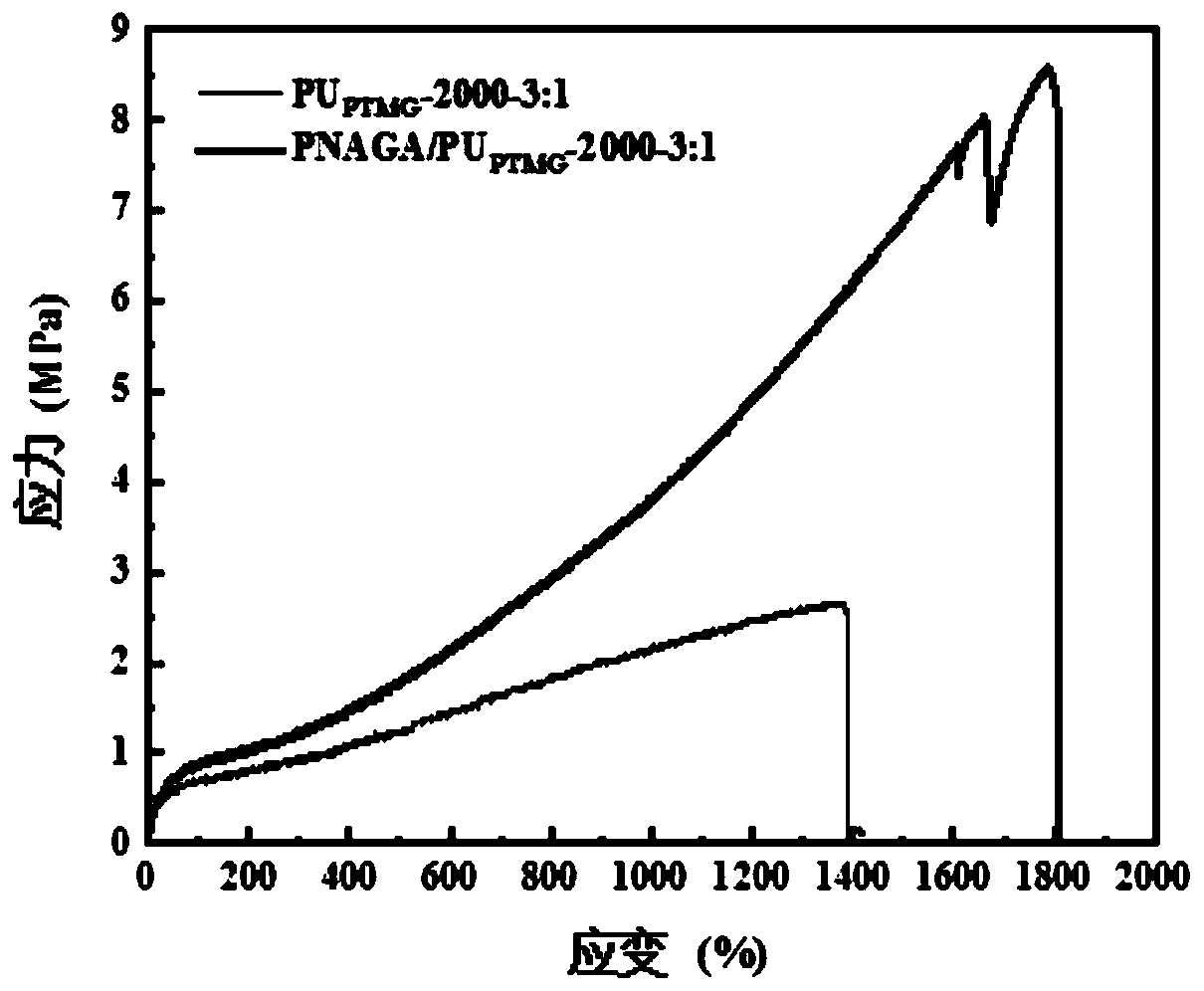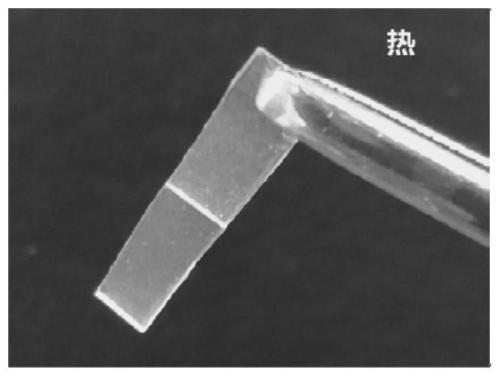Polyacryloyl glycinamide-polyurethane self-repairing elastomer
A polyacryloyl glycinamide self-healing technology, which is applied in the field of polyacryloyl glycinamide-polyurethane self-healing elastomers, can solve the problems of limiting the repair efficiency of polyurethane materials and the number of repairs, and achieve excellent self-healing performance, The effect of improving mechanical properties
- Summary
- Abstract
- Description
- Claims
- Application Information
AI Technical Summary
Problems solved by technology
Method used
Image
Examples
Embodiment 1
[0046] Example 1. Self-healing elastomer PNAGA / PU PTMG -2000- Preparation of 3:1
[0047] (1) Preparation of NAGA monomer: Add glycinamide hydrochloride (0.095 mol) into a three-necked flask placed in an ice bath, blow nitrogen, add 10 ml of ice water, and stir until completely dissolved. 40ml of glacial ether and 55ml of 2M glacial potassium carbonate solution were successively added to the flask, 0.10mol of acryloyl chloride was dissolved in 40ml of ether, and added to the above mixed solution, and then reacted at room temperature for 2h. Adjust the pH of the solution to 2 with 6M hydrochloric acid solution, remove the organic phase, wash the aqueous solution three times with ether, remove the color of the solution with charcoal, then adjust the pH of the solution to neutral with 2M NaOH solution, freeze-dry and then use ethanol / methanol ( 4 / 1, v / v) solution, and after the solvent evaporated, it was dissolved in ethanol / methanol (4 / 1, v / v) solution at 145°C and recrystalliz...
Embodiment 2
[0050] Embodiment 2 self-healing elastomer PNAGA / PU PTMG -1000- Preparation of 3:1
[0051] (1) Preparation of NAGA monomer: Add glycinamide hydrochloride (0.095 mol) into a three-necked flask placed in an ice bath, blow nitrogen, add 10 ml of ice water, and stir until completely dissolved. 40ml of glacial ether and 55ml of 2M glacial potassium carbonate solution were successively added to the flask, 0.10mol of acryloyl chloride was dissolved in 40ml of ether, and added to the above mixed solution, and then reacted at room temperature for 2h. Adjust the pH of the solution to 2 with 6M hydrochloric acid solution, remove the organic phase, wash the aqueous solution three times with ether, remove the color of the solution with charcoal, then adjust the pH of the solution to neutral with 2M NaOH solution, freeze-dry and then use ethanol / methanol ( 4 / 1, v / v) solution, and after the solvent evaporated, it was dissolved in ethanol / methanol (4 / 1, v / v) solution at 145°C and recrystall...
Embodiment 3
[0054] Embodiment 3 Self-healing elastomer PNAGA / PU PTMG -2000- Preparation of 4:1
[0055] (1) Preparation of NAGA monomer: Add glycinamide hydrochloride (0.095 mol) into a three-necked flask placed in an ice bath, blow nitrogen, add 10 ml of ice water, and stir until completely dissolved. 40ml of glacial ether and 55ml of 2M glacial potassium carbonate solution were successively added to the flask, 0.10mol of acryloyl chloride was dissolved in 40ml of ether, and added to the above mixed solution, and then reacted at room temperature for 2h. Adjust the pH of the solution to 2 with 6M hydrochloric acid solution, remove the organic phase, wash the aqueous solution three times with ether, remove the color of the solution with charcoal, then adjust the pH of the solution to neutral with 2M NaOH solution, freeze-dry and then use ethanol / methanol ( 4 / 1, v / v) solution, and after the solvent evaporated, it was dissolved in ethanol / methanol (4 / 1, v / v) solution at 145°C and recrystall...
PUM
 Login to View More
Login to View More Abstract
Description
Claims
Application Information
 Login to View More
Login to View More - R&D
- Intellectual Property
- Life Sciences
- Materials
- Tech Scout
- Unparalleled Data Quality
- Higher Quality Content
- 60% Fewer Hallucinations
Browse by: Latest US Patents, China's latest patents, Technical Efficacy Thesaurus, Application Domain, Technology Topic, Popular Technical Reports.
© 2025 PatSnap. All rights reserved.Legal|Privacy policy|Modern Slavery Act Transparency Statement|Sitemap|About US| Contact US: help@patsnap.com



